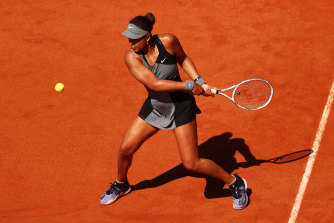Focus on dance between press and stars misses point of Naomi’s saga
A well-known Australian cricketer, let’s call him ‘Steve Waugh’, was once complaining about journalists writing about a recent failure of his. “There could have been some reason behind it,” he said. “I could have had an injury, something might have happened, there could have been an explanation you didn’t know about.”
“But ‘Steve’, was the response, ’you don’t make yourself available for interview unless you’ve made a hundred. If we asked to speak to you after you failed, you’d tell us to get lost.”
Naomi Osaka at the French Open.Credit:Julian Finney/Getty Images.
Beyond that is the bargain struck for the perceived greater good of the sport. A few decades ago, the National Basketball Association broke ground by allowing access for reporters to changing rooms, practice courts, all sorts of outside-the-square locales. A culture of openness infused the sport of basketball, and others took notice. More access, more informal and personal communication between players and media meant more popularity, more growth and more money. It was easier for a reporter to speak one-on-one to LeBron James than it was (and still is) to a second-rank AFL player. Somewhere down the track, so the story goes, this meant more basketball courts, more balls, more opportunities for kids to get out and play.
Basketball led the world, and other sports joined the spirit of openness. Tennis, with its extreme conversion rate of rivers of gold to a minuscule playing population, with its tight possibilities for command and control, embraced the rituals of access. Sure, these actual encounters have long grown stale, but the ritual itself became critical to tennis’s viability as a global professional sport.This controlled flow has been thrown out by the advent of social media and other channels for communication between players and audiences outside of mainstream media.
It is possible that traditional media post-match interviews in all sport are approaching their last day, and you might be surprised how many journalists will celebrate its arrival. But it has not come yet, and for now journalists and participants remain mutually dependent and must suffer each other’s inadequacies.
As Venus Williams says, a player can console herself by knowing that she hits the tennis ball better than all her questioners and all their descendants ever will in a million lifetimes. And the journalists can provide themselves with their own consolations. It might be soothing, but it’s irrelevant and distasteful. When Williams says they ‘can’t hold a candle to me’, her dismissiveness speaks far beyond the walls of the press room.
Ash Barty, as ever, gave the debate a shot of common sense: “We know what we sign up for as professional tennis players. I can’t really comment on what Naomi is feeling or her decisions she makes. At times press conferences are hard, of course, but it’s also not something that bothers me. I’ve never had problems answering questions or being completely honest with you guys. It’s not something that’s ever fazed me too much.”
Not everyone is as well adjusted as Barty, however.
You could not have seen Osaka struggle to speak in public during the past three years without remembering her anxiety and discomfort. It dates back to before Serena Williams’s behaviour spoilt Osaka’s hopes of enjoying her maiden US Open win in 2018, although that occasion gave a vivid glimpse of the young woman’s suffering.
Ultimately this is not a question of communications, marketing or free speech, but of one woman’s health, as real as if she had broken an arm or a leg. Many performers of many kinds hide their struggles with anxiety. Some succumb and some overcome. Let us wish for Osaka to be the lucky kind.
Sports news, results and expert commentary. Sign up for our Sport newsletter.
Most Viewed in Sport
From our partners
Source: Read Full Article

